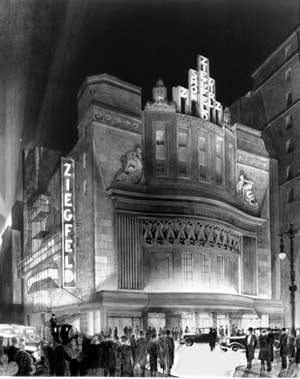 |
|
Ziegfeld Theatre
|
The first major exhibition to focus on architect Joseph Urban's designs for theater and opera will open Oct. 11, at Columbia's Miriam and Ira D. Wallach Art Gallery. "Architect of Dreams: The Theatrical Vision of Joseph Urban" will include approximately 120 watercolors, set models, sketches, book illustrations and architectural drawings, in particular stage designs for the Metropolitan Opera and the Ziegfeld Follies created between 1915 and 1931. An opening reception on Tues., Oct. 10, from 5:00 to 7:00 p.m., is open to all members of the Columbia community.
One of the principal artists responsible for new stagecraft in this country, Urban (1872-1933) has formerly been overlooked in favor of such contemporaries as Robert Edmond Jones. "Despite Urban's acknowledged importance and influence, he has remained surprisingly underrated," said Arnold Aronson, the exhibition's curator, a professor of theatre arts in the Columbia School of the Arts, and a noted authority on the history of set design.
"At the time Urban came on the scene, set design was very cluttered. He simplified, stripped away excess and introduced color in a way it had never been used before," said Aronson.
Born in Vienna at a time of great artistic ferment, Joseph Urban trained as an architect and was influenced by the artists of the Secession (Gustav Klimt, Josef Olbrich, Josef Hoffmann), as well as by the architect Adolf Loos. Later, he was associated with the Wiener Werkstätte. Urban was a central figure in the cultural life of Vienna for more than a decade before immigrating to the United States in 1912 to become the art director of the Boston Opera. In 1914 he moved to New York, where for the next two decades his studio was a major theatrical presence, designing productions especially for the Ziegfeld Follies and the Metropolitan Opera. By the time of his death in 1933, he had designed well over 500 stage sets for more than 168 productions, many of which he also directed.
Urban advanced American stage design through the introduction of the latest European developments, as well as his own experiments with lighting and painterly effects, which often paralleled developments in modernist literature, painting and dance. He straddled the worlds of architecture and theatre, and his ability to integrate them is evident in his work-his buildings are theatrical, while an architectural sensibility infuses his theatrical designs.
Urban's work in diverse fields ranged from the design of residential and commercial buildings (including New York's New School for Social Research and the 1926 Palm Beach mansion Mar-a-Lago) to book illustration (including Hans Christian Anderson's fairy tales) and set and costume design. Famous for his color-and identified with his signature "Urban blue"-he was placed in charge of color choice for the 1933 Chicago World's Fair. He also designed movie sets for William Randolph Hearst's Cosmopolitan Productions. It was precisely this eclecticism that made Urban difficult to pigeonhole and adversely affected his historical standing, according to Aronson. The exhibition is drawn from the archive of Joseph Urban materials at Columbia's Rare Book and Manuscript Library, which is the repository for the largest collection of Urban's work. Many of the works included will be on public view for the first time, including ten recently restored stage models.
In conjunction with the exhibition, the Wallach Art Gallery has published a catalogue that contributes substantially to the scholarship on Joseph Urban, which to date has focused on his architectural career. It includes essays by Aronson; Derek E. Ostergard, the associate director of the Bard Graduate Center for Studies in the Decorative Arts; and Matthew Wilson Smith, a doctoral candidate in theatre at Columbia. More than 100 reproductions, half in color, illustrate the publication.
A symposium with Joseph Urban scholars and theatre professionals will take place Mon., Oct. 30, at 6:00 p.m., in Schermerhorn Hall. It is open to the public free of charge.
The exhibition, the catalogue, and the symposium have made possible, in part, with the generous support of the Austrian Cultural Institute, N.Y.; Dr. Lee MacCormick Edwards; and the Central National Gottesman Foundation. Cataloging of the Joseph Urban archive was made possible by a grant from the National Endowment for the Humanities.
Gallery hours are Wed. through Sat., 1-5 p.m. For more information, call 212-854-2877.
|